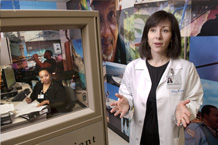Mapping resources, matching needs
- A 65-year-old homebound woman in Woodlawn is having difficulty cooking and cleaning. Her internet-savvy grandson helps her look for meal services and a household helper but doesn’t know what’s available.
- A 17-year-old man in Washington Park thinks he may have been exposed to a sexually transmitted infection. Due to privacy concerns, he’s reluctant to go to a local health center for testing, but he doesn’t know where to turn because he’s uncomfortable traveling outside his neighborhood.
- A physician suspects that one of her patients in Grand Boulevard is depressed. She seeks to refer the patient for psychotherapy, but when she calls some of the agencies on the clinic’s resource list, which was compiled two years earlier, several of the phone numbers are not in service.
In each case, a South Side resident is unable to find needed health care or social services. The Chicago Health and Aging Services Exchange, a new Internet-based information resource, is aimed at addressing such problems by matching people in need of services with the organization best suited to provide those services.
Supported by a $100,000 American Recovery and Reinvestment Act grant from the National Institutes of Health, the Exchange is being designed by community and university collaborators for the South Side Health and Vitality Studies, led by Stacy Lindau, MD, MAPP, Associate Professor of Obstetrics/Gynecology and Medicine-Geriatrics, and Eric Whitaker, MD, MPH, Executive Vice President, Strategic Affiliations and Associate Dean, Community-Based Research, both at the University of Chicago Medical Center. This grant also supports a new collaboration between University of Chicago and Dartmouth Medical School researchers investigating how to best deliver health care with limited resources.
“The ARRA funding allows us to design a web-based marketplace where individuals seeking services can be efficiently matched with community resources,” Lindau says. “It will allow researchers and the public to track supply, demand and quality of key services, distribution of services over time, funding needs and volunteer opportunities.”
Comprehensive, current information exchange
The Exchange grew out of the South Side Health and Vitality Studies’ Community Asset Mapping Project, which provides information about where to find community resources through customized maps that locate resources geographically and in relation to other resources (see www.SouthSideHealth.org). For example, the system shows the Greater Chicago Food Depository pantries in relation to community organizations and businesses.
By the end of the year, the mapping system will include all non-residential establishments, such as health centers, churches, schools and restaurants, for nine South Side communities. The effort is currently funded with public, private and corporate support. Additional funding will be required to cover all 34 South Side communities; to continuously update and expand the information; and to increase community involvement. “We now have funding to add information about services and to disseminate SouthSideHealth.org via community mavens,” said Daniel Johnson, MD, Section Chief of Academic Pediatrics at the University of Chicago Medical Center and faculty leader of the mapping project. “We believe this site will work best as a self-sustaining, community-based effort.”
Whitaker says that “the Exchange will be useful to many constituents, including individuals looking for services, researchers studying how community resources relate to the health and vitality of communities and community-based organizations seeking to identify areas of need. Together, we aim for the South Side of Chicago to become a model of urban health and vitality.”
Ultimately, the project could benefit people and service providers far beyond the South Side. “Our vision is to develop a scalable prototype to address a major problem of matching infrastructures in health and human services,” says Stephen Brown, MSW, LSW, Director of Technology Projects at the University’s Urban Health Initiative.
by Greg Borzo
This award is funded under the American Recovery and Reinvestment Act of 2009, NIH Award number: 1RC4AG038176-01. For more information on NIH's Recovery Act projects, visit http://recovery.nih.gov/.

NIH Recovery Act funding will enable The South Side Health and Vitality Studies, led by Professor Stacy Lindau, MD, (right) and University Executive Vice President Eric Whitaker, MD, to design a web-based marketplace where individuals seeking services can be efficiently matched with community resources. The database will help patient advocates like Lolita Smith (left) who work in emergency rooms to connect patients to primary care medical homes and other community resources as needed.
Photo by Lloyd DeGrane.










